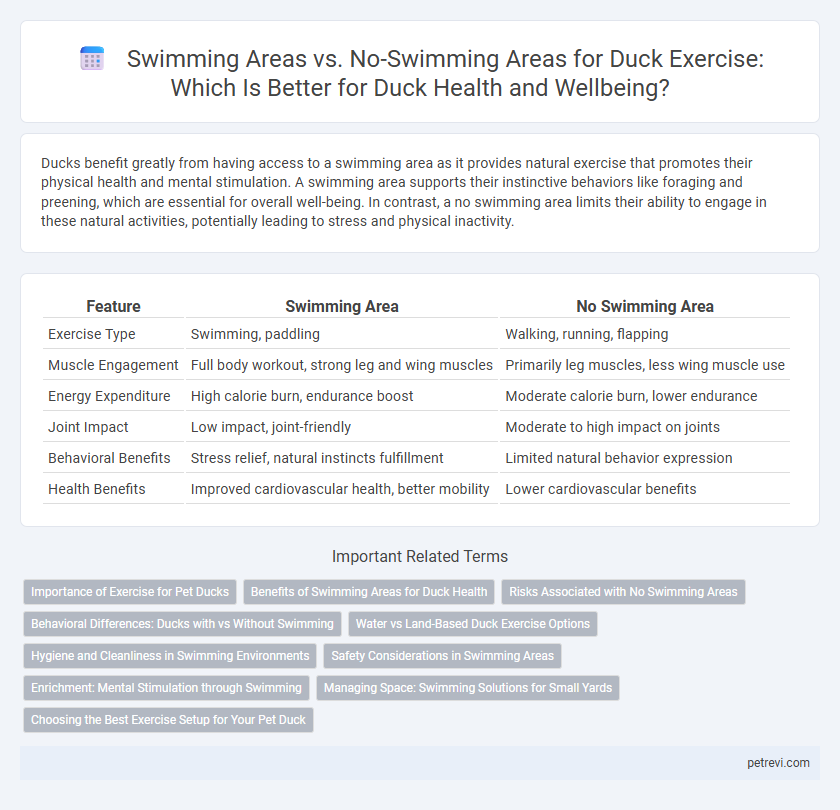Ducks benefit greatly from having access to a swimming area as it provides natural exercise that promotes their physical health and mental stimulation. A swimming area supports their instinctive behaviors like foraging and preening, which are essential for overall well-being. In contrast, a no swimming area limits their ability to engage in these natural activities, potentially leading to stress and physical inactivity.
Table of Comparison
| Feature | Swimming Area | No Swimming Area |
|---|---|---|
| Exercise Type | Swimming, paddling | Walking, running, flapping |
| Muscle Engagement | Full body workout, strong leg and wing muscles | Primarily leg muscles, less wing muscle use |
| Energy Expenditure | High calorie burn, endurance boost | Moderate calorie burn, lower endurance |
| Joint Impact | Low impact, joint-friendly | Moderate to high impact on joints |
| Behavioral Benefits | Stress relief, natural instincts fulfillment | Limited natural behavior expression |
| Health Benefits | Improved cardiovascular health, better mobility | Lower cardiovascular benefits |
Importance of Exercise for Pet Ducks
Regular exercise in designated swimming areas is crucial for pet ducks to maintain their physical health and natural behaviors. Swimming promotes muscle development, improves cardiovascular fitness, and prevents obesity, which is common in sedentary ducks restricted to no swimming zones. Providing access to a swimming area ensures mental stimulation and reduces stress, enhancing overall well-being and longevity of pet ducks.
Benefits of Swimming Areas for Duck Health
Swimming areas provide essential low-impact exercise for ducks, enhancing their cardiovascular health and muscle strength. Access to clean water supports natural foraging behavior and improves feather condition through regular preening, which aids in waterproofing and insulation. Ducks in designated swimming zones experience reduced stress and better overall wellness compared to those restricted to no swimming areas.
Risks Associated with No Swimming Areas
Ducks require regular swimming for exercise, which supports their physical health and feather maintenance. No swimming areas pose risks such as increased stress, muscle atrophy, and poor plumage condition due to lack of water exposure. Restricted access to water can also lead to behavioral issues and decreased overall well-being in ducks.
Behavioral Differences: Ducks with vs Without Swimming
Ducks in designated swimming areas exhibit more natural behaviors such as diving, preening, and foraging, which contribute to enhanced physical fitness and mental stimulation. In contrast, ducks restricted from swimming areas often display increased pacing, feather plucking, and lethargy due to limited exercise and environmental enrichment. Access to aquatic environments is crucial for maintaining typical duck behavioral patterns and overall well-being.
Water vs Land-Based Duck Exercise Options
Ducks benefit significantly from swimming areas, as water provides natural resistance that enhances muscle tone and cardiovascular health while supporting joint mobility. Land-based exercise options, such as walking or foraging, offer essential opportunities for ducks to strengthen their legs and engage in natural behaviors but lack the full-range aquatic conditioning provided by swimming. Balancing both environments ensures comprehensive physical development, promoting optimal health and well-being in ducks.
Hygiene and Cleanliness in Swimming Environments
Designated swimming areas for ducks prioritize hygiene and cleanliness by incorporating filtered water systems and routine maintenance to minimize algae growth and waste accumulation. In contrast, no swimming areas often result in stagnant water conditions, increasing bacterial buildup and posing health risks to ducks through contaminated water. Maintaining clean swimming environments enhances duck exercise benefits while reducing exposure to pathogens and promoting overall avian well-being.
Safety Considerations in Swimming Areas
Swimming areas designated for ducks provide a controlled environment that minimizes risks from predators and pollutants, ensuring safer exercise conditions. No swimming areas pose hazards such as strong currents, contaminated water, and insufficient escape routes, which can compromise duck safety during exercise. Properly maintained swimming zones reduce the incidence of injury and stress, promoting healthy physical activity for ducks.
Enrichment: Mental Stimulation through Swimming
Swimming areas provide ducks with essential mental stimulation by encouraging natural behaviors such as foraging and navigation, enhancing cognitive function. In contrast, no swimming areas limit these activities, potentially leading to boredom and reduced environmental engagement. Access to water for swimming enriches ducks' daily routines, promoting overall well-being and mental health.
Managing Space: Swimming Solutions for Small Yards
Designating a Swimming Area allows ducks to engage in natural behaviors, promoting physical exercise and mental stimulation essential for their health. No Swimming Areas require alternative enrichment methods like shallow water trays or misting systems to compensate for limited water access in small yards. Efficient space management combines water features with dry zones to maximize movement while maintaining hygiene and ease of care.
Choosing the Best Exercise Setup for Your Pet Duck
Designating a swimming area for your pet duck provides essential physical exercise that supports muscle development and overall health, while promoting natural behaviors such as diving and preening. In contrast, a no swimming area limits water access, potentially leading to decreased physical fitness and behavioral issues due to restricted movement. Optimal exercise setups balance safe, accessible swimming zones with dry spaces, ensuring ducks receive both aquatic activity and land-based exercise for comprehensive well-being.
Swimming Area vs No Swimming Area for Duck exercise Infographic

 petrevi.com
petrevi.com